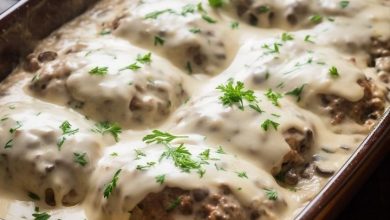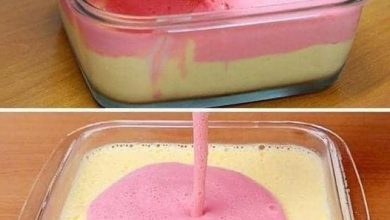Classic French Bread Recipe

ADVERTISEMENT
Classic French Bread Recipe
Introduction
Classic French Bread is a simple yet elegant loaf known for its crispy, golden crust and soft, airy interior. With just a few basic ingredients, you can create a delicious homemade version of this staple bread that’s perfect for any occasion. Whether you’re serving it with your favorite soup, making sandwiches, or enjoying it fresh out of the oven, this French bread is sure to impress!
Ingredients
- 3 1/2 cups (440g) all-purpose flour
- 1 1/2 teaspoons salt
- 2 teaspoons granulated sugar
- 2 teaspoons active dry yeast
- 1 1/4 cups (300ml) warm water (around 110°F or 45°C)
- 1 tablespoon olive oil (optional, for softer crust)
- 1 tablespoon cornmeal (for dusting)
- 1 egg (for egg wash, optional, for a golden crust)
Instructions
1. Activate the yeast:
- In a small bowl, combine the warm water, sugar, and yeast. Stir until the sugar dissolves. Let it sit for about 5–10 minutes until the mixture becomes frothy. If the mixture doesn’t foam, the yeast might be inactive, and you’ll need to try a fresh packet of yeast.
2. Mix the dough:
- In a large mixing bowl, combine the flour and salt.
- Once the yeast mixture is frothy, add it to the flour and salt mixture, and stir until it forms a dough.
- If you’re using olive oil, add it to the dough at this stage. The oil will help soften the crust and make the bread slightly richer in flavor.
3. Knead the dough:
- Turn the dough out onto a lightly floured surface and knead for about 8–10 minutes, until the dough is smooth and elastic. If the dough is too sticky, sprinkle a little more flour; if it’s too dry, add a small amount of water, a tablespoon at a time.
- Alternatively, you can use a stand mixer with a dough hook on medium speed for about 5–7 minutes.
4. Let the dough rise:
ADVERTISEMENT
- Place the dough in a lightly oiled bowl, covering it with a clean kitchen towel or plastic wrap. Let it rise in a warm place for about 1 hour, or until it doubles in size.
5. Shape the dough:
- Once the dough has risen, punch it down gently to release any air bubbles.
- Turn the dough out onto a floured surface and shape it into a long loaf (about 12-14 inches).
- Place the shaped loaf on a baking sheet dusted with cornmeal, or you can line it with parchment paper.
6. Second rise:
- Cover the loaf with a towel and let it rise for about 30–45 minutes, or until it puffs up slightly.
7. Prepare the egg wash (optional):
- If you want a golden, shiny crust, beat the egg in a small bowl and brush it over the top of the loaf before baking. This step is optional, but it adds a beautiful finish.
8. Preheat the oven:
- While the dough is rising, preheat your oven to 450°F (230°C). Place an empty baking dish or pan on the bottom rack of the oven to create steam during baking, which will help form a crispy crust.
9. Bake the bread:
ADVERTISEMENT
- Once the bread is ready, score the top of the loaf with a sharp knife or razor blade (this helps the bread expand evenly as it bakes).
- Place the loaf in the oven and pour a small amount of water into the hot baking dish (creating steam).
- Bake for about 25–30 minutes, or until the bread is golden brown and sounds hollow when tapped on the bottom. If you want a darker, crunchier crust, bake for an additional 5 minutes.
10. Cool the bread:
- Let the bread cool on a wire rack for at least 20 minutes before slicing. This will allow the crumb to set and prevent the bread from becoming gummy inside.
Tips for Success
- Yeast activation: Always ensure the water is not too hot when activating the yeast. If it’s too hot, it can kill the yeast, and the bread won’t rise properly.
- Steam for crust: Adding steam in the oven helps the crust form beautifully, so don’t skip the water in the baking dish!
- Storing the bread: Store your bread in a paper bag or wrapped in a clean kitchen towel to preserve the texture. Avoid using plastic bags, as they can make the bread soft and soggy.
Conclusion
This Classic French Bread recipe will give you a golden, crusty loaf with a soft, airy interior, perfect for any occasion. The bread is versatile enough to enjoy on its own, make into sandwiches, or serve as a side with soups or stews. Once you try homemade French bread, you’ll find it hard to go back to store-bought!
Would you like to experiment with different flavors, such as adding herbs or garlic for a twist? 😊




